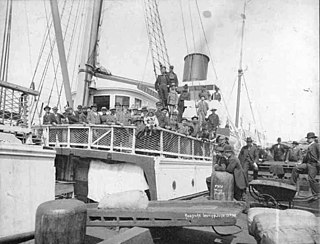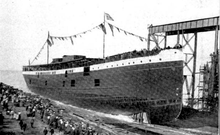
Empress of Ireland was a British-built ocean liner that sank near the mouth of the Saint Lawrence River in Canada following a collision in thick fog with the Norwegian collier Storstad in the early hours of 29 May 1914. Although the ship was equipped with watertight compartments and, in the aftermath of the Titanic disaster two years earlier, carried more than enough lifeboats for all aboard, she foundered in only 14 minutes. Of the 1,477 people on board, 1,012 died, making it the worst peacetime maritime disaster in Canadian history.

SS Mongolia was a 13,369-ton passenger-and-cargo liner originally built for Pacific Mail Steamship Company in 1904. She later sailed as USS Mongolia (ID-1615) for the U.S. Navy, as SS President Fillmore for the Dollar Line and as SS Panamanian for Cia Transatlantica Centroamericano.

SS Servia, also known as RMS Servia, was a successful transatlantic passenger and mail steamer of revolutionary design, built by J & G Thomson of Clydebank and launched in 1881. She was the first large ocean liner to be built of steel instead of iron, and the first Cunard ship to have an electric lighting installation.

Campania was a British ocean liner owned by the Cunard Line, built by Fairfield Shipbuilding and Engineering Company of Govan, Scotland, and launched on Thursday, 8 September 1892.

The PS Washington Irving was a 4,000-short-ton (3,600 t) sidewheel day boat and the flagship of the Hudson River Day Line that operated on the Hudson River from 1913 to 1926.

The Baltimore Steam Packet Company, nicknamed the Old Bay Line, was an American steamship line from 1840 to 1962 that provided overnight steamboat service on Chesapeake Bay, primarily between Baltimore, Maryland, and Norfolk, Virginia. Called a "packet" for the mail packets carried on government mail contracts, the term in the 19th century came to mean a steamer line operating on a regular, fixed daily schedule between two or more cities. When it closed in 1962 after 122 years of existence, it was the last surviving overnight steamship passenger service in the United States.

SS Manchuria was a passenger and cargo liner launched 1903 for the San Francisco-trans Pacific service of the Pacific Mail Steamship Company. During World War I the ship was commissioned 25 April 1918–11 September 1919 for United States Navy service as USS Manchuria (ID-1633). After return to civilian service the ship was acquired by the Dollar Steamship Line in 1928 until that line suffered financial difficulties in 1938 and ownership of Manchuria was taken over by the United States Maritime Commission which chartered the ship to American President Lines which operated her as President Johnson. During World War II she operated as a War Shipping Administration transport with American President Lines its agent allocated to United States Army requirements. After World War II, she was returned to American President Lines, sold and renamed Santa Cruz. The liner was scrapped in Italy in 1952.

SS Yorktown was launched February 10, 1894, by Delaware River Iron Ship Building and Engine Works, Chester, Pennsylvania for the Old Dominion Steamship Company for the company's overnight New York City/Norfolk, Virginia service. The United States Navy purchased Yorktown on April 21, 1898, to be commissioned as the second USS Resolute, an auxiliary cruiser and transport that saw naval service during the Spanish–American War 1898–1899. The United States Department of War acquired the ship on January 22, 1900, for service as the United States Army Transport (USAT) Rawlins. The ship was sold to the Merchants and Miners Transportation Company of Baltimore, Maryland on July 27, 1901, and renamed Powhatan. Powhatan was wrecked in 1916 and in 1919 rebuilt as the world's first turbo-electric propelled passenger ship Cuba for luxury passenger and express freight service between Florida and Cuba with the Miami Steamship Company beginning service in 1920. Renamed Seneca, the ship burned and sank December 30, 1927, at Hoboken, New Jersey then refloated September 2, 1928, and scrapped.

SS President was a British passenger liner that was the largest ship in the world when she was commissioned in 1840, and the first steamship to founder on the transatlantic run when she was lost at sea with all 136 onboard in March 1841. She was the largest passenger ship in the world from 1840 to 1841. The ship's owner, the British and American Steam Navigation Company, collapsed as a result of the disappearance.

The SS Nantucket was the last steam-powered ferry in regular operation on the East Coast of the United States. She was owned and operated by the Woods Hole, Martha's Vineyard and Nantucket Steamship Authority between 1957 and 1987.

Commonwealth was a large sidewheel steamboat built in 1854–55 for passenger service on Long Island Sound. The most celebrated Sound steamer of her day, Commonwealth was especially noted for the elegance and comfort of her passenger accommodations, which included gas lighting, steam heating, and an "enchantingly beautiful" domed roof in her upper saloon. Her stability of motion led her captain to describe Commonwealth as the finest rough weather steamboat ever built in the United States.

Chelosin was a steel-hulled, steam-powered passenger-freighter vessel that served in coastal British Columbia from 1911 to 1949, under the ownership of the Union Steamship Company of British Columbia.

City of Lowell was a twin screw passenger steamer launched on 21 November 1893 by Bath Iron Works and delivered in July 1894 for the Norwich & New York Transportation Company for use on Long Island Sound. The Norwich Line, operated by the New York and New England Railroad, placed the steamer on the overnight service between New York and New London, Connecticut. Passengers connected by rail at New London for Boston and Worcester, Massachusetts. The ship was in commercial operation until 1939 when apparently laid up awaiting scrapping. At the outbreak of World War II City of Lowell was acquired by the War Shipping Administration with eventual transfer of title to the War Department for use as an Army troop transport. The ship was sold to Potomac Shipwrecking Company of Washington, D.C. in November 1946 for scrapping.

SS Roanoke (1882–1916) was a passenger and cargo ship built by John Roach & Sons in Chester, Pennsylvania. The Roanoke was built for the Old Dominion Steamship Company's service from New York to Norfolk Virginia. In 1898 the ship was sold to the North American Transportation and Trading Company to take miners, supplies and gold between Seattle and ports in Alaska. Later the Roanoke was sold to the Oregon-based North Pacific Steamship Company. In 1907, the Roanoke helped to rescue the survivors of her former running mate Columbia. On May 9, 1916, the Roanoke sank in heavy seas off the California coast near San Luis Obispo with the loss of 47 lives. There were only three survivors.

SS Bulgaria was a passenger-cargo steamship built in 1898 for the Hamburg American Line ("Hapag"). During World War I, she operated as a United States Army animal and cargo ship under the names USAT Hercules and USAT Philippines, and after the war was converted into the troop transport USS Philippines (ID-1677).

The SS Scandinavian was a steamship built at Harland & Wolff in Belfast which entered service as an ocean liner in 1898. The ship changed names and owners several times; she was originally built for the Dominion Line and was known as New England, in 1903 she was transferred to the White Star Line and renamed Romanic. In 1912 she was sold to the Allan Line and renamed Scandinavian, the name which she retained for the rest of her career.

Mohawk was a steam passenger ship built in 1908 by William Cramp & Sons of Philadelphia for Clyde Steamship Company with intention of operating between New England and southern ports of the United States. In early January 1925 the ship caught fire off New Jersey coast and eventually was abandoned and scuttled by the crew without a loss of life.

Senator was a wooden, side-wheel steamship built in New York in 1848. She was one of the first steamships on the California coast and arguably one of the most commercially successful, arriving in San Francisco at the height of the California gold rush. She was the first ocean-going steamer to sail up the Sacramento River to reach the new gold fields. After more purpose-built river steamers became available, Senator began a 26-year long career sailing between San Francisco and Southern California ports. Age and improving technology finally made the ship unsuitable for passenger service by 1882. Her machinery was removed and she was converted into a coal hulk. She ended her days in New Zealand, where she was broken up sometime around 1912.

SS Moltke was a German ocean liner built by Blohm & Voss for the Hamburg America Line. She was named after Helmuth von Moltke. Sister ship to the SS Blücher, she was launched in 1901, and sailed her maiden voyage in February the following year. According to the New Haven Morning Journal and Courier, she "was built for the eastern service of the line, but on nearing completion her interior arrangements were adapted to the New York service at Hamburg." Her first commanding officer was Captain Christian Dempwolf.

Adriatic was a wooden-hulled, side-wheel steamship launched in New York in 1856. She was conceived as the largest, fastest, most luxurious trans-Atlantic passenger liner of her day, the pride of the Collins Line. At the time of her launch she was the largest ship in the world.
























